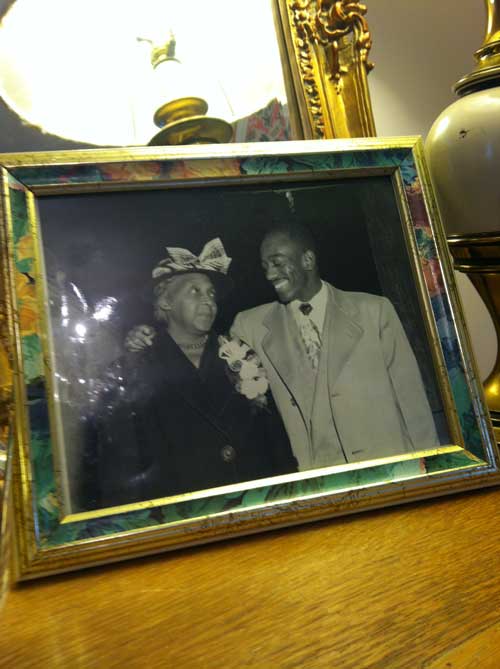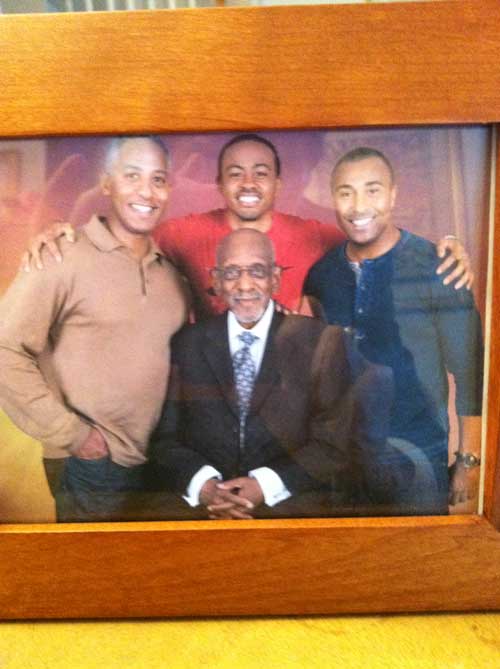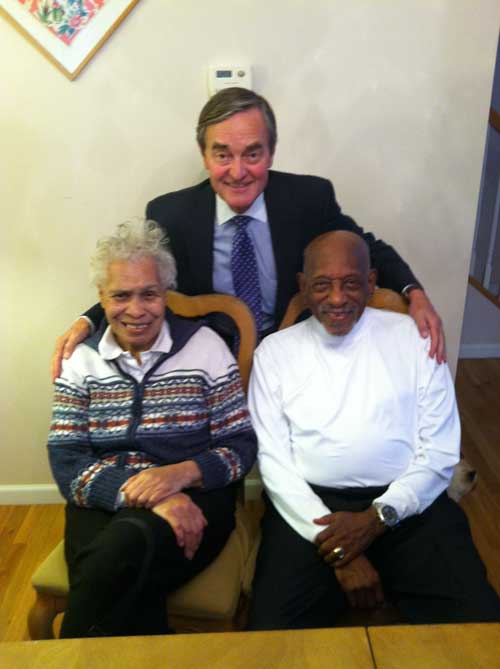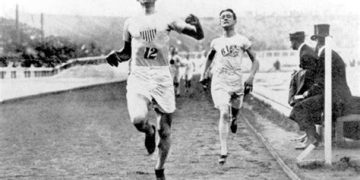The Greatest Hurdler
Sharing Memories With Harrison Dillard – 90 Years Young
Over
sixty years ago, Harrison Dillard was a highly visible and celebrated
track & field athlete. What a career he had. The Ohio native
remains the only man ever to win Olympic titles in both the hurdles and
the sprints. Overall, he won 4 Olympic gold medals in the ’48 London
and ’52 Helsinki Games. In 1955 Dillard won the Sullivan Award –
emblematic of America’s top amateur athlete. And the man they called
“Bones” is the only high hurdler inducted into the IAAF Athletics Hall
of Fame. Without question, Harrison Dillard is one of the most prolific
track & field athletes of all time.

Bones with his influential mother Tareh who advised him: “Pay no attention to what
others say. You know what you can do.”
It is sad – and frankly inexcusable – that an entire generation of younger track & field enthusiasts knows very little about this great athlete and the storybook tale of his 1948 Olympic Trials disaster and his ultimate redemption in the London and Helsinki Games.
In the post-World War II area, high hurdler Harrison Dillard was one of the most dominating track & field athletes of his or any era. By mid-1948 Dillard was riding a streak of 82 consecutive wins spiced by his world record victory [13.6 seconds] in the 120 yard high hurdles at the 1948 Kansas Relays. He was considered a lock to win the Olympic Trials high hurdles and head off to London to capture the gold. But the 90-year old Dillard has vivid memories of the disaster that unfolded in the OT final. “I ticked the first hurdle with my lead heel,” Dillard recalls. “I got over the second hurdle. And then, it was just bang, bang, bang, bang. I just hit hurdle after hurdle. And when we got to the 8th hurdle, I didn’t even jump to clear it – I was so far off rhythm. There was no point in even trying to finish the race because I was so far behind from having hit so many hurdles with my lead foot.”

The iconic photo of four world record hurdlers: Renaldo Nehemiah, Aries Merritt, and
Colin Jackson encircle Harrison Dillard.
Nobody was more stunned than Dillard. “I felt terrible” adds Dillard, now able to laugh over 65 years later. “I suppose if I ever wanted to cry about a race, that probably would have been it. I thought I was going to win. But that was one of those days. I guess they say that’s why they run the race.”
Fortunately the disconsolate hurdler had earlier qualified for the 1948 U.S. Olympic team by squeezing out a third place finish in the 100 meter OT final held the previous day. Abruptly foreclosed of the opportunity to compete for hurdles gold, Dillard didn’t dwell on that lost opportunity. He went to work. “I was on the team already,” Dillard reflects. “So that took a lot of the shock and the hurt out.” How would he sharpen his sprinting in the two weeks between the Trials and the Games? “I worked on starts.”
Block work paid off when Dillard got to the London Games. With explosive starts, Dillard posted leading times as he progressed through the early rounds and found himself in the 100 meter final with Americans Barney Ewell and Mel Patton. After a blanket finish in the final where the fast-finishing Ewell closed decisively on the quick-starting Dillard at the tape, Ewell went into a celebratory victory dance. Dillard remained poised. “I thought I had won,” explains Dillard. “I just ran through the tape. I didn’t dive for the tape as you would in a race you thought you were behind in. I definitely thought I had won.” The sprint finalists waited nervously as the officials huddled to conduct a first-time-ever Olympic finish line photo examination. Dillard smiles as he recalls what happened next. “When Barney went into this dance thinking he had won, [Panamanian sprinter and eventual bronze medalist] Lloyd LaBeach looked at Barney and said, ‘No mon. You don’t win. Bones win.’ Then the official announcement came down. And sure enough, I had beaten him by about 18 inches.”
Dillard came back to the states clutching his 100 meter gold medal – and another one he earned running the third leg on the victorious U.S.A. 4 x 100 relay team. But the London sprint champ had his eye on some unfinished business: capturing that elusive 110H Olympic gold medal 4 years hence. In the intervening years, the Olympic hero balanced his front office position with the Cleveland Indians with his pursuit of the Olympic hurdles title. Quietly and effectively supported by his influential mother Terah – “Harrison, pay no attention to what others may say. You know what you can do.” – the young athlete worked on his hurdle game.
Dillard’s hurdle technique was not his strong suit. “I had an unorthodox trail leg,” admits the hurdle legend. “My knee used to come up under my arm. Nowadays a coach would probably give you lashes,” he laughs. But Dillard had other strengths that more than compensated any technique flaws. The 5′ 10″ ’48 Olympic 100 meter champion obviously had great speed. “But I also was very flexible. Because of my lack of height, I had to be. Otherwise, I couldn’t have gotten any type of drive over the hurdle.” Dillard also found a way to turn his smaller stature into a key ingredient of his blazing start. “Almost nobody could beat me to the first hurdle,” he adds. “All the big guys would come too close to the hurdles. They would always have to mince and chop their steps at the start. They’d have to take a very short first step. And I could take a first step that was just a shade longer. But I would try to take my longer first step just as quickly as they took for their shorter first step. And that is what I think helped me with my start.” What about the current emerging technique used by 2012 Olympic champion Aries Merritt and others of a 7-step drive to the first hurdle? “Aries and I have talked about that. I think I was using 9 steps to the first hurdle. I don’t know how they do it,” admits Dillard.
Those intervening years sharpening his start and first hurdle drive may just have been the difference. In the Helsinki 110H Olympic final, Dillard got away quickly and eked out a .09 second victory over American teammate Jack Davis. The quest was now complete. His high hurdles gold medal in the ’52 Olympics- combined with yet another gold in the 4 x 100 relay – gave Harrison Dillard 4 Olympic gold medals – matching the Olympic gold haul of his hero Jesse Owens.
Dillard had a mentor-type friendship with the elder Owens, ten years his senior. They raced only once – an exhibition 120 yard low hurdles match race. Dillard – still in high school – was overmatched against the 27 year old low hurdle world record holder and lost by 4 yards. “But I cherish the memories of that race,” Dillard reminisces. “This was my idol.” Dillard smiles as he recalls Owens’ playful advice to him upon learning that Dillard was dating Owens’ niece. “Jesse told me, ‘She can’t help you win any races.’ – and he winked!”
The most appropriate capstone to the career of Harrison Dillard was his recognition as the recipient of the 1955 James A. Sullivan Award – awarded annually to “the outstanding amateur athlete in the United States” with special consideration given to “those who have shown strong moral character.” “I believe my Sullivan Award was in recognition of my background and my character – never in any trouble or any incidents of a negative nature,” Dillard observes. And with his characteristic humility Dillard exclaims, “Jesse Owens never won the Sullivan Award. And if he didn’t get it in 1936, they shouldn’t even have one!”
The man widely regarded as one of the great gentlemen of the sport we love has some uncomplicated and straight-forward advice for today’s track & field athletes. “Just to be a good human being first is really just as important as any single thing,” Dillard suggests. “The same things that applied now I think applied then. The ones who sacrifice and work the hardest, they’re the ones that have the most success. Learn about your sport. Study the people who have been successful and why they were successful and you’ll probably be successful yourself.”

Yours truly embracing: (i) Bernice Robinson Holland / hurdler and high jumper on the
1948 USA Olympic team; and (ii) Harrison Dillard, 4-time Olympic gold medalist.
Those passionate about track & field have an obligation to preserve the heritage of this the greatest of sports. The elders who know the incredible athletes and the lore of yesteryear must see that the revered history of athletics is passed along in detail to the next generation. And the youngers must recognize the importance of these performers, respect their accomplishments on the track and in the field, and understand that all of this occurred in the absence of professional compensation; sophisticated training programs; all-weather track surfaces; highly developed nutritional regimens, 21st century shoes, apparel, and implements; etc. Going back to the first Olympic Games in 1896, there are more than a few impressive athletes – like Harrison Dillard – whose inspiring careers need to be preserved and shared. And there just might not be a more compelling tale than the impressive story of the world’s greatest hurdler.
~Dave Hunter





















